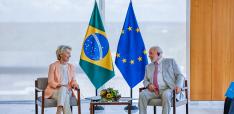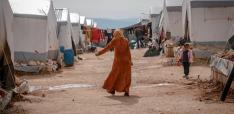The Women, Peace and Security Agenda in the Implementation of the Triple Nexus

This is the eleventh chapter in a forthcoming e-book, entitled 'The Triple Humanitarian, Development and Peace Nexus: In Context and Everyday Perspective', edited by Marina Ferrero Baselga and Rodrigo Mena. Chapters are currently being serialised on Global Policy.
This chapter is based on a research study on the Women, Peace and Security Agenda (WPS) in the implementation of the triple Humanitarian, Development and Peace (HDP) Nexus within the framework of Spanish Development Cooperation. Through interviews, workshops, seminars, and qualitative analysis of projects in various contexts (Colombia, El Salvador, Ethiopia, Mali, Mozambique, Niger and Jordan), we are developing a study that will lead to concrete recommendations and an adaptable methodology for implementing the WPS Agenda and the HDP approach in different contexts. Hereafter, we will present some elements of the analysis, including the relevance of convergence between the WPS Agenda and the HDP approach, the key elements of articulation identified, and the opportunities and challenges in a context of change in the international system.
There is consensus on the relevance of moving towards greater convergence between the Women, Peace and Security Agenda and the implementation of the Triple Nexus approach. The two agendas have been implemented separately until now: the WPS Agenda in the political sphere and the HDP approach in the spheres of development cooperation and humanitarian action. However, greater convergence could strengthen both agendas and enable joint efforts to achieve substantial progress.
25º Anniversary of UN Security Council Resolution 1325 on Women, Peace and Security
The WPS Agenda has a long history. In October 2000, the United Nations Security Council adopted Resolution 1325 on Women, Peace and Security. This Resolution marked a turning point in the inclusion of a gender perspective in peacebuilding. It is one of the most cited resolutions, has been translated into more than 100 languages, and has had a significant impact at the local, national, and multilateral levels. The UNSC Resolution 1325 recognises women as peacebuilders who play a key role in the prevention of violent conflicts, the participation in peace negotiations, and the rehabilitation, relief, and recovery processes. It also highlights the differential impact of armed conflict on women and girls and the enormous burdens they bear as women. Among the issues to be addressed are sexual violence in armed conflict, the use of women's bodies as weapons of war, and persistent impunity for perpetrators.
UNSC Resolution 1325 on WPS is part of a broader regulatory and political framework that has been developed with the adoption of nine other complementary resolutions, as well as other instruments for the defence of gender equality and women's rights in the multilateral sphere, such as the Convention on the Elimination of All Forms of Discrimination Against Women (CEDAW) and the Beijing Platform for Action.
Currently, 96 countries have National Action Plans (NAPs) for the implementation of UNSC Resolution 1325. These NAPs are periodically updated to address current challenges. Some of them have received international cooperation support for their development and implementation. The meaningful participation of civil society organisations, particularly women's and feminist organisations, has been a relevant feature of the NAPs. The Agenda's potential lies in the formation of an international women's movement that mobilises and demands a greater representation in decision-making spaces, both locally and internationally, in favour of peace and equality. And so, these NAPs have become a tool for political advocacy at the local, national, and international levels. Greater convergence and coordination with other agendas can contribute to advancing these demands and strengthening the organisations operating in different areas.
In 2025, UNSC Resolution 1325 celebrates its 25th anniversary, and the overall balance remains uneven. Recognition has been achieved of the gendered impacts of armed conflict and humanitarian crises, as well as the role of women as peacebuilders with “agency” to participate in peace processes. At the same time, the implementation of the Agenda faces significant constraints and challenges. These include obstacles to participation in peace dialogues and negotiations, persistent sexual violence and impunity for this crime in conflicts, and insufficient funding for feminist and women’s groups' initiatives. There is also a lack of political will to promote substantial changes that would challenge the patriarchal structures that perpetuate the “continuum of violence” faced by women living in conflict zones.
Relevance of WPS-HDP convergence
The Triple Nexus approach can help overcome some of these obstacles. It arises in a context of complex and protracted humanitarian crises that require approaches that go beyond the provision of immediate assistance to address the needs of the population. It is an integrated approach that prioritises prevention and development without compromising humanitarian action. In 2019, the OECD Development Assistance Committee (DAC) presented a framework document that offers a set of recommendations and principles for implementing the Triple Nexus approach and states that the objective is: “At the centre of strengthening the coherence between humanitarian, development and peace efforts, is the aim of effectively reducing people’s needs, risks and vulnerabilities, supporting prevention efforts and thus, shifting from delivering humanitarian assistance to ending need” (OECD, 2019: 3). Furthermore, as pointed out in its report Gender equality across the humanitarian development peace Nexus, there are interlinkages between contexts of fragility and gender inequality.
The Triple Nexus offers an opportunity to translate the proposals of the WPS Agenda in the areas of prevention, participation, protection and relief into concrete actions on the ground. In turn, the WPS Agenda can encourage governments to increase their commitment to actions carried out within the framework of the Triple Nexus on the ground and recognise the role of local actors, particularly women, in these processes.
This is why the WPS Agenda and HDP Nexus approach are interconnected, as both frameworks seek to address the structural causes of vulnerability, inequality and violence from a gender perspective. Integrating the two agendas allows for a holistic approach that mutually reinforces them.
Converging the HDP Nexus approach and the WPS Agenda provides an opportunity to coordinate integrated actions that simultaneously address humanitarian, development and peacebuilding needs, with a strong gender focus. For example, in Ethiopia (Tigray), we found that projects integrate the three pillars of the HDP Nexus and the WPS Agenda to eradicate violence against women, promoting peace and resilience through participatory methodologies, trauma recovery training, teacher training, and community dialogues with local leaders and organisations.
Localisation
One of the most significant areas of convergence between the WPS Agenda and the Triple Nexus approach concerns localisation and contextual analysis. Focusing on local actors and including local knowledge is considered essential, as highlighted in the analysed project in Cabo Delgado, Mozambique.
Local perceptions, relational dynamics and leadership must be considered throughout the design, planning and implementation of the project. The aim is to identify local capacities for conflict management by exploring the connectors and dividers within the community, which may vary depending on the context. In these processes, it is crucial to incorporate a gender perspective and empower women as agents of change, with a great capacity for transformation. For example, women human rights defenders play an essential role in localising the WPS Agenda. At the local level, they address inequalities and generate collective peace-building processes that challenge power relations and the patriarchal, racist and classist systems that generate violence. Women and men can play a diversity of roles in conflict situations, whether as victims or agents of peace, which must be acknowledged. An intersectional approach that considers factors such as age, ethnicity and social class must also be adopted.
Localisation cannot be a simple mechanical transposition of rationalities and methodologies. Instead, it must be developed through dialogue with local stakeholders, connecting different levels of action from the local to the national and international. Effective localisation requires consideration of the socio-cultural context, everyday experiences, and women's capacity for action — factors that are frequently disregarded in top-down policy approaches. In some contexts, local actions are shaped by local structures and norms that can both facilitate and limit the transformative potential of the WPS Agenda.
Localisation must consider the structural and cultural obstacles that limit women's participation and their capacity for action. The context specificity, local ownership and adapting the norm to everyday practice must be considered. At times, the National Action Plans of Resolution 1325 have failed to adequately address the specific needs of women, highlighting the need for more context-specific and bottom-up approaches. Local ownership of these NAPS must be encouraged, as must the participation of local women's organisations.
Women Peacebuilders and National Action Plans
There is extensive experience of integrating a gender perspective into peacebuilding as well as recognizing women’s roles in peace and post-conflict processes. This experience provides valuable insights into how to implement the Triple Nexus, particularly with regard to the peace pillar. As the case studies of Colombia and Mali illustrate, National Action Plans (NAPs) can catalyse the development of regional and local action plans, fostering synergies across different levels of implementation. However, it is crucial to ensure that localisation is carried out from the bottom up. El Salvador, for instance, has a National Action Plan, but it has not been relevant for incorporating a gender perspective into post-conflict actions. Intergenerational dialogues between women have been held, along with activities to overcome trauma and develop women's historical memory.
Conclusion
In summary, the convergence between the Triple Nexus and the Women, Peace and Security (WPS) Agenda provides an opportunity to transform existing practices into robust theoretical and operational proposals that foster resilience, empowerment and peace by highlighting the pivotal role of women as agents of peace. These challenges encourage deeper dialogue between different narratives and actors at various levels, as well as the redefinition of operational frameworks, financing mechanisms and coordination strategies. This will enable the three dimensions of the Nexus and the WPS Agenda to be realised sustainably.
Overall, the analysis of the projects examined in this research suggests that integrating the WPS Agenda and the Triple Nexus is effective when actions are designed with a strong local focus, combining immediate crisis response, capacity building, and long-term peacebuilding, while actively promoting women's participation as agents of social transformation.
In the context of changes in the international system, with a significant reduction in funds allocated to humanitarian action and development cooperation, it is important to move forward in changing working methods and promoting multidisciplinary teamwork that facilitates the implementation of the Triple Nexus and integration with other agendas, such as the WPS Agenda. Overcoming silos and developing institutional capacity to work in an integrated manner, while also mainstreaming gender perspectives, is essential. Convergence between the Triple Nexus and the WPS Agenda provides an opportunity to redefine operational frameworks, financing mechanisms and coordination strategies, enabling a meaningful and sustainable articulation of the three dimensions of the Nexus with the WPS Agenda.
Manuela Mesa and Elena Boschiero are researchers at the Centre for Education and Research for Peace and are carrying out the project: “The Women, Peace and Security Agenda in the implementation of the Triple Nexus HDP in Spanish Development Cooperation”. This project is funded by the AECID.
Photo by Ahmed akacha


